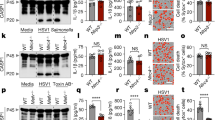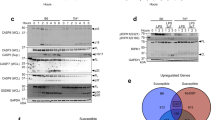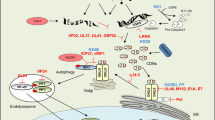Abstract
The caspase-recruitment domain–containing adaptor protein CARD9 regulates the innate signaling responses to fungal infection. Here we show that CARD9 is required for innate immune responses against intracellular pathogens. We generated Card9−/− mice and found that CARD9-deficient macrophages had defects in activation of the kinases p38 and Jnk but not of transcription factor NF-κB after bacterial and viral infection. CARD9-deficient mice failed to clear infection and showed altered cytokine production after challenge with Listeria monocytogenes. In wild-type cells, we found CARD9 inducibly associated with both the intracellular 'biosensor' Nod2 and the serine-threonine kinase RICK. Our data demonstrate that CARD9 has a critical function in Nod2-mediated activation of p38 and Jnk in innate immune responses to intracellular pathogens.
This is a preview of subscription content, access via your institution
Access options
Subscribe to this journal
Receive 12 print issues and online access
$209.00 per year
only $17.42 per issue
Buy this article
- Purchase on Springer Link
- Instant access to full article PDF
Prices may be subject to local taxes which are calculated during checkout








Similar content being viewed by others
References
Akira, S., Uematsu, S. & Takeuchi, O. Pathogen recognition and innate immunity. Cell 124, 783–801 (2006).
Medzhitov, R. Toll-like receptors and innate immunity. Nat. Rev. Immunol. 1, 135–145 (2001).
Akira, S. & Takeda, K. Toll-like receptor signalling. Nat. Rev. Immunol. 4, 499–511 (2004).
Yamamoto, M. et al. TRAM is specifically involved in the Toll-like receptor 4-mediated MyD88-independent signaling pathway. Nat. Immunol. 4, 1144–1150 (2003).
Kawai, T., Adachi, O., Ogawa, T., Takeda, K. & Akira, S. Unresponsiveness of MyD88-deficient mice to endotoxin. Immunity 11, 115–122 (1999).
Matsuguchi, T., Masuda, A., Sugimoto, K., Nagai, Y. & Yoshikai, Y. JNK-interacting protein 3 associates with Toll-like receptor 4 and is involved in LPS-mediated JNK activation. EMBO J. 22, 4455–4464 (2003).
Fitzgerald, K.A. et al. LPS-TLR4 signaling to IRF-3/7 and NF-κB involves the toll adapters TRAM and TRIF. J. Exp. Med. 198, 1043–1055 (2003).
Oganesyan, G. et al. Critical role of TRAF3 in the Toll-like receptor-dependent and -independent antiviral response. Nature 439, 208–211 (2006).
Hacker, H. et al. Specificity in Toll-like receptor signalling through distinct effector functions of TRAF3 and TRAF6. Nature 439, 204–207 (2006).
Kopp, E. & Medzhitov, R. Recognition of microbial infection by Toll-like receptors. Curr. Opin. Immunol. 15, 396–401 (2003).
Takeda, K., Kaisho, T. & Akira, S. Toll-like receptors. Annu. Rev. Immunol. 21, 335–376 (2003).
Inohara, N., Chamaillard, M., McDonald, C. & Nunez, G. NOD-LRR proteins: role in host-microbial interactions and inflammatory disease. Annu. Rev. Biochem. 74, 355–383 (2005).
Yoneyama, M. et al. The RNA helicase RIG-I has an essential function in double-stranded RNA-induced innate antiviral responses. Nat. Immunol. 5, 730–737 (2004).
Inohara, N. et al. Host recognition of bacterial muramyl dipeptide mediated through NOD2. Implications for Crohn's disease. J. Biol. Chem. 278, 5509–5512 (2003).
Xu, L.G. et al. VISA is an adapter protein required for virus-triggered IFN-β signaling. Mol. Cell 19, 727–740 (2005).
Seth, R.B., Sun, L., Ea, C.K. & Chen, Z.J. Identification and characterization of MAVS, a mitochondrial antiviral signaling protein that activates NF-κB and IRF 3. Cell 122, 669–682 (2005).
Kawai, T. et al. IPS-1, an adaptor triggering RIG-I- and Mda5-mediated type I interferon induction. Nat. Immunol. 6, 981–988 (2005).
Meylan, E. et al. Cardif is an adaptor protein in the RIG-I antiviral pathway and is targeted by hepatitis C virus. Nature 437, 1167–1172 (2005).
Chin, A.I. et al. Involvement of receptor-interacting protein 2 in innate and adaptive immune responses. Nature 416, 190–194 (2002).
Kobayashi, K. et al. RICK/Rip2/CARDIAK mediates signalling for receptors of the innate and adaptive immune systems. Nature 416, 194–199 (2002).
Sun, Q. et al. The specific and essential role of MAVS in antiviral innate immune responses. Immunity 24, 633–642 (2006).
Bertin, J. et al. CARD9 is a novel caspase recruitment domain-containing protein that interacts with BCL10/CLAP and activates NF-κB. J. Biol. Chem. 275, 41082–41086 (2000).
Nakamura, S. et al. Overexpression of caspase recruitment domain (CARD) membrane-associated guanylate kinase 1 (CARMA1) and CARD9 in primary gastric B-cell lymphoma. Cancer 104, 1885–1893 (2005).
Gross, O. et al. Card9 controls a non-TLR signalling pathway for innate anti-fungal immunity. Nature 442, 651–656 (2006).
Wang, D. et al. A requirement for CARMA1 in TCR-induced NF-κB activation. Nat. Immunol. 3, 830–835 (2002).
Han, J. & Ulevitch, R.J. Limiting inflammatory responses during activation of innate immunity. Nat. Immunol. 6, 1198–1205 (2005).
Ashwell, J.D. The many paths to p38 mitogen-activated protein kinase activation in the immune system. Nat. Rev. Immunol. 6, 532–540 (2006).
Dong, C., Davis, R.J. & Flavell, R.A. MAP kinases in the immune response. Annu. Rev. Immunol. 20, 55–72 (2002).
Alexopoulou, L., Holt, A.C., Medzhitov, R. & Flavell, R.A. Recognition of double-stranded RNA and activation of NF-κB by Toll-like receptor 3. Nature 413, 732–738 (2001).
Takeuchi, O. et al. Differential roles of TLR2 and TLR4 in recognition of gram-negative and gram-positive bacterial cell wall components. Immunity 11, 443–451 (1999).
Girardin, S.E. et al. Nod2 is a general sensor of peptidoglycan through muramyl dipeptide (MDP) detection. J. Biol. Chem. 278, 8869–8872 (2003).
Duramad, O. et al. IL-10 regulates plasmacytoid dendritic cell response to CpG containing immunostimulatory sequences. Blood 102, 4487–4492 (2003).
Edelson, B. & Unanue, E. MyD88-dependent but Toll-like receptor 2-independent innate immunity to Listeria: no role for either in macrophage listericidal activity. J. Immunol. 169, 3869–3875 (2002).
Acknowledgements
We thank K. Schluns (M.D. Anderson Cancer Center) for reagents, and G. Nunez (University of Michigan) and G. Cheng (University of California at Los Angeles) for hemagglutinin-tagged Nod2, Myc-tagged RICK and Flag-tagged RICK. Supported by the National Institutes of Health, the Leukemia and Lymphoma Society (X.L.), the Cancer Research Institute (X.L.) and the MD Anderson Cancer Center (Y.L.).
Author information
Authors and Affiliations
Contributions
Y.-M.S.H., Y.Z., Y.Y., D.W., H.L. and O.D. performed the experiments. X.-F.Q., C.D. and X.L. analyzed the data.
Corresponding author
Ethics declarations
Competing interests
The authors declare no competing financial interests.
Supplementary information
Supplementary Fig. 1
Generation of Card9−/− mice. (PDF 224 kb)
Supplementary Fig. 2
CARD9 expression in lung and specific lymphoid organs. (PDF 154 kb)
Supplementary Fig. 3
CARD9 is required for the production of TNF upon selective microbial mimetic stimulation. (PDF 159 kb)
Supplementary Fig. 4
Microbial mimetic–stimulated Card9 deficient macrophages exhibit a dosage-dependent reduction in IL-6 production. (PDF 169 kb)
Supplementary Fig. 5
LPS and FSL-1-induced cytokine production is normal in CARD9-deficient macrophages. (PDF 188 kb)
Supplementary Fig. 6
MAPK activation and IκBα degradation are not altered in CARD9-deficient macrophages upon LPS or pure-LPS stimulation. (PDF 225 kb)
Supplementary Fig. 7
Virus-induced IL-6 and TNF transcription is defective in CARD9-deficient macrophages. (PDF 171 kb)
Supplementary Fig. 8
CARD9 overexpression leads to enhanced p38 and Jnk phosphorylation but not NF-κB activation. (PDF 225 kb)
Supplementary Fig. 9
Working model showing that CARD9 mediates Nod2-induced innate immune response through p38 and JNK activation. (PDF 91 kb)
Supplementary Fig. 10
Card9 deficiency leads to sustained spleen enlargement and inflammation upon listeria infection. (PDF 197 kb)
Rights and permissions
About this article
Cite this article
Hsu, YM., Zhang, Y., You, Y. et al. The adaptor protein CARD9 is required for innate immune responses to intracellular pathogens. Nat Immunol 8, 198–205 (2007). https://doi.org/10.1038/ni1426
Received:
Accepted:
Published:
Issue Date:
DOI: https://doi.org/10.1038/ni1426
This article is cited by
-
Macrophage CARD9 mediates cardiac injury following myocardial infarction through regulation of lipocalin 2 expression
Signal Transduction and Targeted Therapy (2023)
-
Card9 protects sepsis by regulating Ripk2-mediated activation of NLRP3 inflammasome in macrophages
Cell Death & Disease (2022)
-
CARD9 Expression Pattern, Gene Dosage, and Immunodeficiency Phenotype Revisited
Journal of Clinical Immunology (2022)
-
Ten decadal advances in fungal biology leading towards human well-being
Fungal Diversity (2022)
-
TRIM41 is required to innate antiviral response by polyubiquitinating BCL10 and recruiting NEMO
Signal Transduction and Targeted Therapy (2021)



